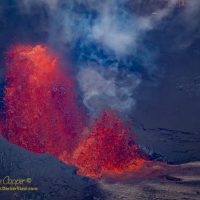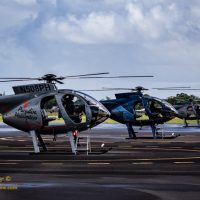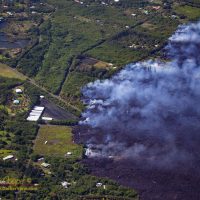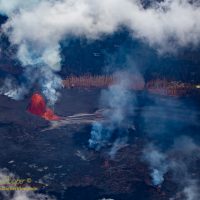How to get a good look at this eruption? Not a trivial question. The neighborhoods involved are under mandatory evacuation orders enforced by police and National Guard checkpoints. Quite a few people have been arrested and cited while trying to get closer to the lava.

This is the first major change in the eruptions of Kilauea in decades. This eruption features phenomena seen in the old documentaries, lava fountains hundreds of feet high, huge flows cutting through the rainforest. Things I have always wanted to see.
As much as I would like to visit, we have simply not tried to get into lower Puna. It is just not pono to interfere with residents frantically trying to salvage whatever they can ahead of the flows, or emergency services already overburdened with the ongoing situation.
Two legal ways exist for visitors to get a closer look… Fly or float. Either take a helicopter ride over the eruption, or take one of the lava boats to an ocean entry.
The boats have resumed tours, but active ocean entries have been sporadic, running for a week, then stopping. As of Monday morning the lava has re-entered the ocean at Kapoho Bay, and is again view-able from the water. The boat runs also involve a fairly long run all the way from Hilo harbor. The boat ramp the tours once used at Pohoiki now cut off by the flows.
Thus the only semi-reliable way is by helicopter. Semi-reliable? Weather and flight restrictions do limit this access method. The weather in Hilo and Puna is usually cloudy, and often raining, limiting flight operations. Still… A helicopter is the only way to see the whole area, from the lava fountains to the ocean entry.
Shortly after the eruption started the FAA issued a TFR, temporary flight restriction in the airspace of lower Puna. This TFR compels aircraft to stay above 3,000ft AGL without special permission from local emergency services.
The helicopters offer by far the best option right now. The best view of the vents and flows, The price is not all that bad either. Paradise helicopter’s doors off tour is $324 per person, quite a bit less for kamaʻaina.
Thus Deb and I decided to try to fly to the eruption for viewing, booking a flight for the morning of May 26th.
Our first attempt? Not good. Just minutes before we were to walk out to the heli we were told the flight was cancelled due to weather. The announcement hit hard, after the anticipation for this flight and much of a day blown driving to Hilo and back… All for naught. With the cancellation our average was 1 for 3 in successful attempts.
I gave the eruption a few days before re-booking the flight. Time enough for the disappointment to fade and to ensure the eruption was not pausing. Our next attempt would be the morning of June 3rd.
This second time was successful, we took off on schedule. Flying through broken clouds the heli headed for the eruption. As we flew I was reminded of the advantages and disadvantages of flying in a helicopter with no doors.
We arrived first over Kapoho. Here a lava flow front a half mile across was burning through farms just above Kaopoho Bay. It was a heartbreaking sight to see these farms burning. Here were greenhouses being inundated, over there a cell phone tower toppled into the lava flow.
The lava was about a quarter mile from the water, in its stood path hundreds of homes in the Kapoho Farm Lots and Vactionland subdivisions. I scanned with the telephoto lens, shooting as fast as the camera would allow.
We turned and headed up along the flow as an expanse of lava, burned homes, and skeletal trees testified to the devastation along the flow’s path.
Fissure 8 was simply spectacular, a raging fountain of lava hundreds of feet high. The sight was both stunning and horrifying. Spectacular as a phenomena of raw nature. Horrifying in the realization that this abundant supply of lava will continue on to destroy Kapoho Bay, the surrounding neighborhoods and farms, and the Waiʻopae Tidepools.
And indeed, over the next two days the flow did just that, burying one of the most beautiful parts of this island under an enormous aʻa flow, sparing nothing in the path. Kapoho Bay is simply gone, replaced by a new point of land jutting out nearly a mile from the old shoreline. As the island watched, we saw the worst come to pass. The entire island mourned.
There were helicopters everywhere, our pilot often dropping out of our conversation to chat with the other aircraft and coordinate our flight path. I understand that the helicopter companies have brought in additional aircraft from the other islands to meet the demand, probably the only tourism based businesses doing well during this eruption.
We flew back along the flow to Kapoho and the flow front. I shot a few last images of Kapoho Bay, the last I will ever take. From there it was back along the coast to Hilo. We flew over a couple waterfalls, but my mind was back at the lava, replaying the sights we had just witnessed.
Since childhood I have known what a cinder cone was, marveling at the old photos of lava fountains hundreds of feet high. I had always wanted to see such a sight, living on the island of Hawaiʻi it finally seemed possible. Bucket list item complete… Lava fountain seen and photographed. I never dreamed the the lava would erupt in the middle of a neighborhood and cause such destruction.















